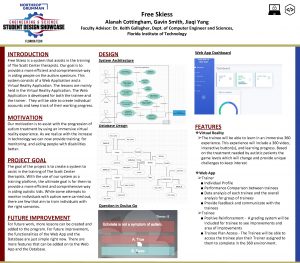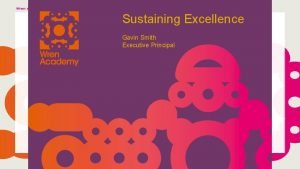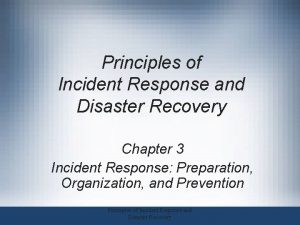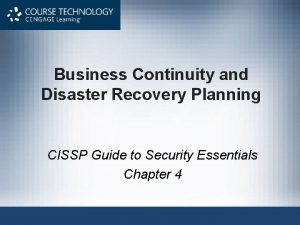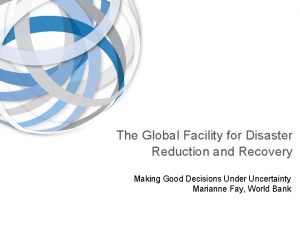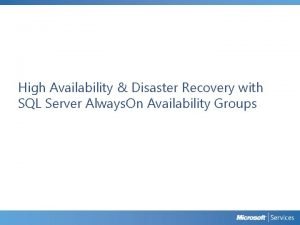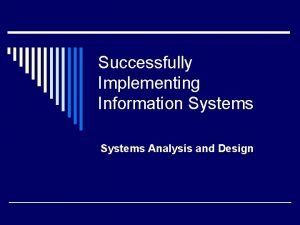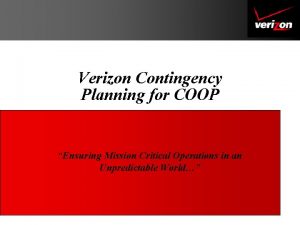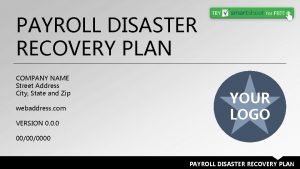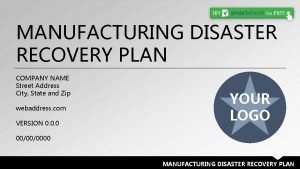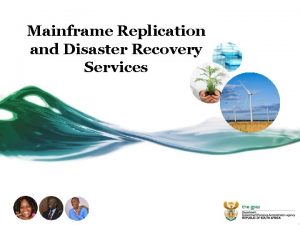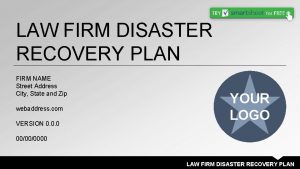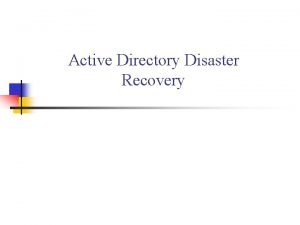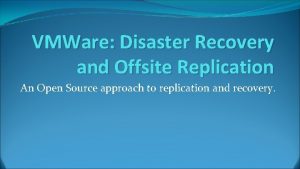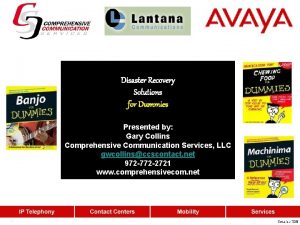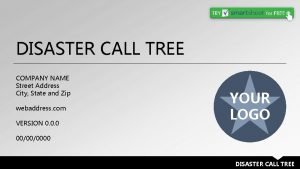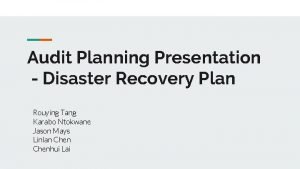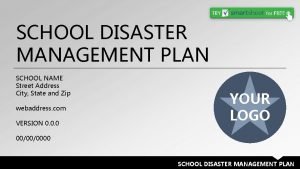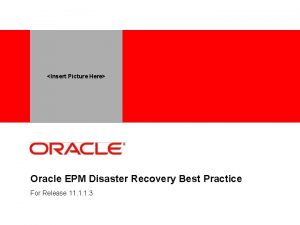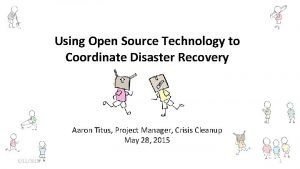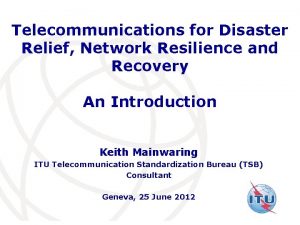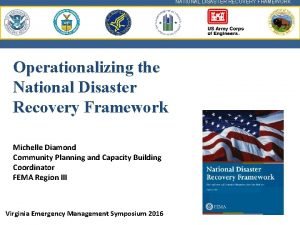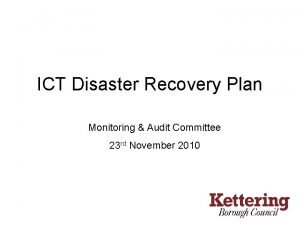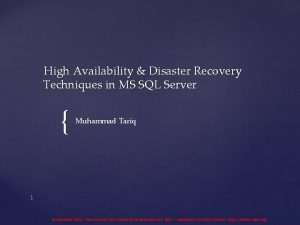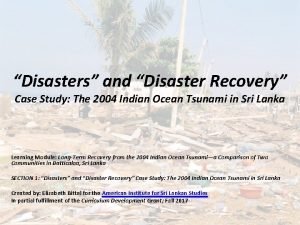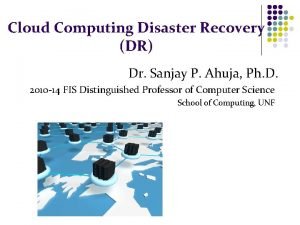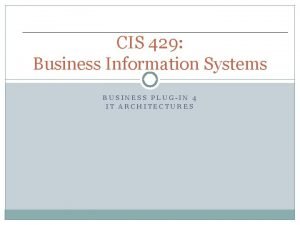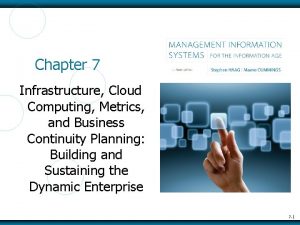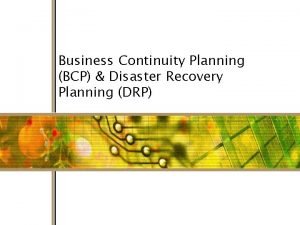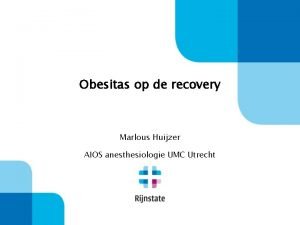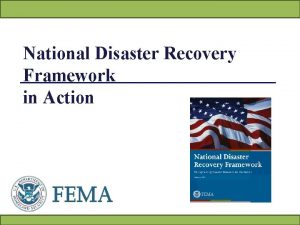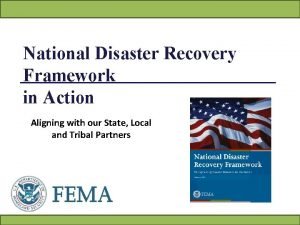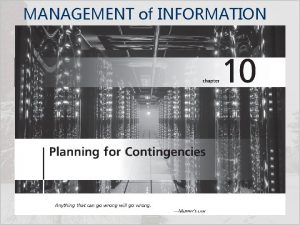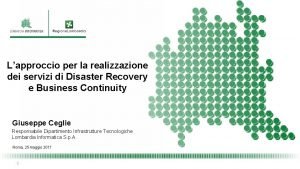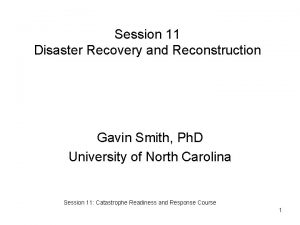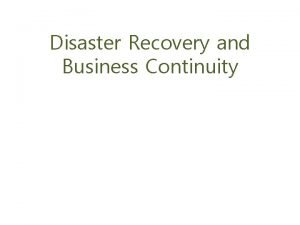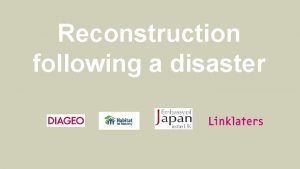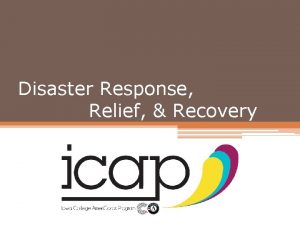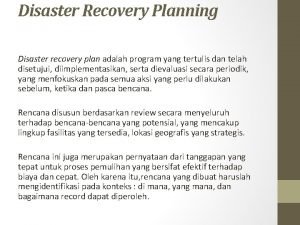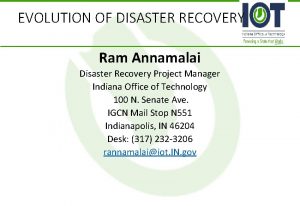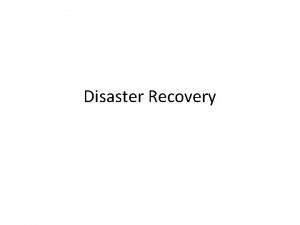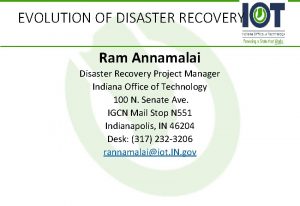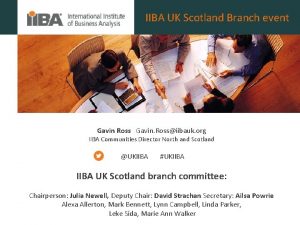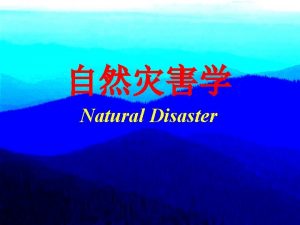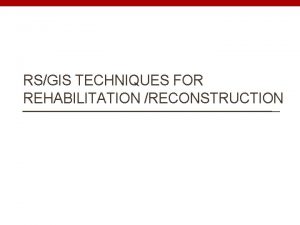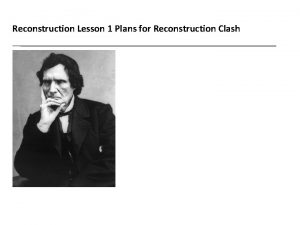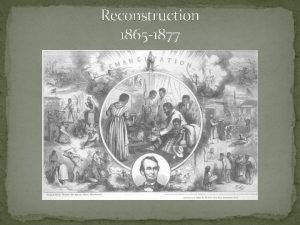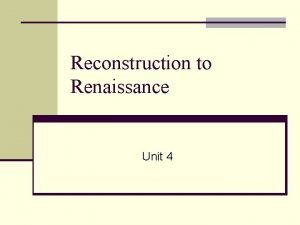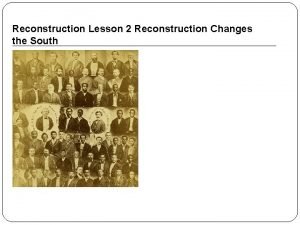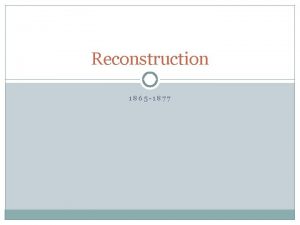Session 10 Disaster Recovery and Reconstruction Gavin Smith














































- Slides: 46

Session 10 Disaster Recovery and Reconstruction Gavin Smith, Ph. D University of North Carolina Session 10: Catastrophe Readiness and Response Course

Learning Objectives • 10. 1 Describe disaster recovery, including the issues faced following a major and catastrophic disaster • 10. 2 Discuss stakeholders and their roles in recovery • 10. 3 Describe and analyze the United States Disaster Recovery Assistance Framework

Defining Disaster Recovery • Disaster recovery: “The differential process of restoring, rebuilding and reshaping the physical, social, economic and natural environment through pre-event planning and post-event actions” (Smith and Wenger 2006) • Catastrophic disaster recovery Session 10: Catastrophe Readiness and Response Course

Disaster Outcomes • Positive Outcomes: – Hazard Mitigation – Education – Post-Event “window of opportunity” – Increased investment – Decreased levels of social conflict Session 10: Catastrophe Readiness and Response Course

Disaster Outcomes • Negative Outcomes: – Degradation of the environment – Failure to assist socially vulnerable populations – Long-term or permanent closure of businesses – Reduced investment – Increased social conflict Session 10: Catastrophe Readiness and Response Course

In-Class Discussion • Discuss the concept of a disaster as a “window of opportunity” – Who are the beneficiaries and losers following disaster?

Elements of Recovery • Physical Recovery – Reconstruction • Social Recovery – Emergent groups • Economic Recovery – Continuity of operations plan • Environmental Recovery Session 10: Catastrophe Readiness and Response Course

In-Class Discussion • How do catastrophes impact the physical recovery or reconstruction of impacted communities? • Issues to consider include: – Scope of the event – Duration of recovery – Intensity of the event

In-Class Discussion • In the case of sea-level rise, how should coastal communities - which are highly dependent on tourism, tax revenue from ocean-front properties and the harvesting of coastal marine life (which are dependent on the health of degraded wetlands) - address these and other identified economic recovery challenges?

Disaster Recovery Process • The process emerges from the initial response to a disaster and transitions into initial short-term recovery efforts • Recovery involves more than reconstruction • Following a major or catastrophic disaster recovery can take more than a decade (in some locations, organizations and individuals will never return to their pre -disaster condition) • The transition from short-term to long-term recovery is often difficult and uncertain Session 10: Catastrophe Readiness and Response Course

In-Class Discussion • Should Hurricane Katrina be categorized as a catastrophic event? Why or why not? • Are there other measures of physical, economic, social and environmental impacts that should be considered? If so, what are they?

Disaster Recovery Process Session 10: Catastrophe Readiness and Response Course

Disaster Recovery Process • Emergency Period • Restoration Period • Reconstruction II Session 10: Catastrophe Readiness and Response Course

In-Class Discussion • Does this model adequately address the issues associated with a catastrophic event? If not, what factors are missing? – Missing elements – Other critiques

10. 2 Discuss Stakeholders and their Roles in Recovery • Stakeholders: – Public Sector (federal, state and local governments) – Quasi-governmental and Non-governmental (regional planning organizations, professional associations, colleges and universities) – Nonprofit Relief Organizations (non-profits and foundations) – International Aid Organizations and Nations – Private Sector and For-Profit Organizations (businesses and corporations, financial and lending institutions, insurance, media) – Emergent Groups and Individuals Session 10: Catastrophe Readiness and Response Course

Public Sector • Key Federal Agencies: – – – – FEMA Small Business Administration U. S. Army Corps of Engineers National Oceanic and Atmospheric Administration Department of Housing and Urban Development The Military Others • National Response Framework Session 10: Catastrophe Readiness and Response Course

Emergency Support Functions (as defined by FEMA) • • • ESF #1 ESF #2 ESF #3 ESF #4 ESF #5 ESF #6 • • • ESF #7 ESF #8 ESF #9 ESF #10 ESF #11 ESF #12 ESF #13 ESF #14 ESF #15 Transportation Communications Public Works and Engineering Firefighting Emergency Management Mass Care, Emergency Assistance, Housing and Human Services Resource Support Public Health and Medical Services Search and Rescue Oil and Hazardous Materials Response Agriculture and Natural Resources Energy Public Safety and Security Long-Term Community Recovery External Affairs Session 10: Catastrophe Readiness and Response Course

State Agencies and Organizations • • • State Emergency Management Agency Governor’s Office State Legislature Department of Natural Resources Department of Commerce State Budget Office State Planning Office Department of Public Health Others Session 10: Catastrophe Readiness and Response Course

State Emergency Management Agency • Maintained by each state • Responsibilities: – Oversee “comprehensive” emergency management program – Develop and implement training, education and outreach program – Coordination of state assets and agencies after a disaster – Liaison to FEMA pre- and post-event – Administrator of federal programs following disasters • Public Assistance • Hazard Mitigation Grant Program • Individual Assistance – Administration of state recovery programs (if they exist) Session 10: Catastrophe Readiness and Response Course

Governor’s Office • • • Emergency Powers designation Committing state assets State disaster declaration Establish evacuation routes Request federal assistance following disasters Designating a State Coordinating Officer Enter into mutual aid agreements Public face of disaster Seek additional funding through state legislature Session 10: Catastrophe Readiness and Response Course

State Legislature • Appropriate state funds for disaster assistance – Non-federal match – State programs – State “rainy day” fund • Establish post-disaster recovery commission • State budget – emergency management Session 10: Catastrophe Readiness and Response Course

Local Government • Government Actors: – – – – – City Manager Financial Official Public Works Director Planning Director Police Chief Fire Chief Building Official Local Floodplain Administrator Local Emergency Manager Session 10: Catastrophe Readiness and Response Course

Quasi-governmental and Nongovernmental Organizations • Regional planning organizations • Professional associations • Colleges and universities Session 10: Catastrophe Readiness and Response Course

Regional Planning Organizations • Write and implement local grant programs • Local land-use planning and plan-writing • Collect and analyze data • Assume local governance tasks Session 10: Catastrophe Readiness and Response Course

Professional Associations • Critically analyze recovery activities / offer solutions • Provide expert opinion • Mobilize association members • Conduct post-disaster damage assessments • Provide pre- and post-disaster planning assistance • Advocate for changes in building standards, codes or other activities tied to their area of expertise Session 10: Catastrophe Readiness and Response Course

Professional associations involved in recovery include: • Association of State Floodplain Managers • National Emergency Management Association • International Association of Emergency Managers • American Planning Association • American Institute of Architects

Colleges and Universities • Conduct hazards-related research • Teach growing cadre of students interested in hazards management • Provide post-event technical assistance Session 10: Catastrophe Readiness and Response Course

Non-profit Relief Organizations • Non-profits: – Food, shelter, clothing, medical assistance, counseling and crisis management – Repair and reconstruction of damaged housing – Advocate for the protection of natural systems – Capacity building – Technical experts • Foundations: – – Provision of gap funding Share information Mobilize public opinion Identify shortfalls in the recovery assistance system Session 10: Catastrophe Readiness and Response Course

International Aid Organizations and Nations • Link international assistance with local needs • Identify appropriate diplomatic channels/organizations to funnel relief • Draw international attention to a major disaster or catastrophe Session 10: Catastrophe Readiness and Response Course

Private Sector and For-Profit Organizations The Private Sector includes the following organizations: • Businesses and Corporations – Financial and Lending Institutions – Insurance – Media

Business and Corporations • Contractors and consultants: – – • • • Debris removal Deployment of assets Writing and administering of grants Repairing and reconstruction following disaster Local business aid Corporate aid Financial and lending aid Insurance Media Session 10: Catastrophe Readiness and Response Course

Emergent Groups and Individuals • Emergent Groups: – Share information – Advocate for the equitable distribution of assistance – Assert the nature of local needs • Individuals – Share experiential lessons – Identify and articulate local needs – Grass-roots activism Session 10: Catastrophe Readiness and Response Course

10. 3 The Disaster Recovery Assistance Framework • Members of the Disaster Assistance Network: – Public Sector – Quasi-governmental and Nongovernmental Organizations – Nonprofit Relief Organizations – International Aid Organizations and Nations – Private Sector and For-Profit Organizations – Emergent Groups and Individuals Session 10: Catastrophe Readiness and Response Course

The Disaster Recovery Assistance Framework • Types of Assistance: – Funding – Policy – Technical Assistance • Framework Characteristics: – Rules and understanding of local needs – Timing of disaster assistance – Horizontal and vertical integration Session 10: Catastrophe Readiness and Response Course

Rules and Understanding of Local Needs Session 10: Catastrophe Readiness and Response Course

Timing of Disaster Assistance Session 10: Catastrophe Readiness and Response Course

In-Class Discussion • How does the adoption of hazard mitigation measures slow or speed the process of disaster recovery? – Issues to consider include: • The timeframe in which mitigation measures are implemented • The role of pre-disaster hazard mitigation planning Session 10: Catastrophe Readiness and Response Course

Horizontal and Vertical Integration Session 10: Catastrophe Readiness and Response Course

Disaster Recovery Planning • Benefits of recovery planning – Berke, Kartez and Wenger (1993) – Oliver-Smith (1990) – Olson, Olson and Gawronski (1998) – Findings largely qualitative Session 10: Catastrophe Readiness and Response Course

Recovery Planning • Pre-disaster – Planning tools (see Figure 4) • Post-disaster – Emergency phase – Long-term recovery and reconstruction • Importance of planning process – – Public participation Policy dialogue Facilitation Negotiated rule-making Session 10: Catastrophe Readiness and Response Course

The Disaster Recovery Plan • Evaluation of existing plans and policies • Assessment of legal authorities • Creation of local recovery committee • Implementation strategy Session 10: Catastrophe Readiness and Response Course

The Disaster Recovery Plan • Topical elements: – – – Damage and needs assessments Post-disaster permitting Building moratorium Debris management Restoration of public services Repair of infrastructure Critical facilities Housing (emergency shelter, temporary, permanent) Public health, social services Business and economic recovery Hazard mitigation Session 10: Catastrophe Readiness and Response Course

Reluctance to Plan for Recovery • Negative outcomes: – Poor coordination (horizontal and vertical) among stakeholder groups – Increased length of time required to recover – Lower levels of public participation – Reduced understanding of local needs – Missed opportunities to incorporate hazard mitigation into recovery – Increased dependence on federal assistance following disasters Session 10: Catastrophe Readiness and Response Course

In-Class Exercise • Discuss the Model Recovery and Reconstruction Ordinance (Schwab, et. al. 1998) in the context of the Disaster Assistance Framework Session 10: Catastrophe Readiness and Response Course

Take Home Exercise • Create an outline of a disaster recovery plan for your hometown or designated community Session 10: Catastrophe Readiness and Response Course

In-Class Discussions • Discuss the factors that could stimulate a greater awareness of the importance of pre-event planning for post-disaster recovery • Discuss and critically analyze the Disaster Assistance Framework Session 10: Catastrophe Readiness and Response Course
 Pc gavin smith
Pc gavin smith Gavin smith wren academy
Gavin smith wren academy Principles of incident response and disaster recovery
Principles of incident response and disaster recovery Backup and disaster recovery mississippi
Backup and disaster recovery mississippi Cissp disaster recovery steps
Cissp disaster recovery steps Socio economic trends
Socio economic trends Always on disaster recovery
Always on disaster recovery Read-scale availability groups
Read-scale availability groups Principles of incident response and disaster recovery
Principles of incident response and disaster recovery Disaster recovery planning in system analysis and design
Disaster recovery planning in system analysis and design Verizon coop
Verizon coop Payroll disaster recovery plan
Payroll disaster recovery plan Manufacturing disaster recovery
Manufacturing disaster recovery Mainframe disaster recovery services
Mainframe disaster recovery services Law firm disaster recovery plan
Law firm disaster recovery plan Emc disaster recovery
Emc disaster recovery Records management disaster recovery plan
Records management disaster recovery plan Oracle business continuity plan
Oracle business continuity plan Active directory disaster recovery best practices
Active directory disaster recovery best practices Isaca business continuity
Isaca business continuity Vmware offsite disaster recovery
Vmware offsite disaster recovery Hot site cold site warm site disaster recovery
Hot site cold site warm site disaster recovery Disaster recovery for dummies
Disaster recovery for dummies Disaster recovery call tree template
Disaster recovery call tree template Disaster recovery plan presentation
Disaster recovery plan presentation School disaster recovery plan
School disaster recovery plan Database disaster recovery plan
Database disaster recovery plan Oracle ebs disaster recovery plan
Oracle ebs disaster recovery plan Open source disaster recovery
Open source disaster recovery Disaster recovery telecommunications
Disaster recovery telecommunications National disaster recovery framework 2016
National disaster recovery framework 2016 Ict disaster recovery plan
Ict disaster recovery plan Disaster recovery techniques
Disaster recovery techniques Disaster recovery case study examples
Disaster recovery case study examples Coop disaster recovery
Coop disaster recovery Aws disaster recovery pilot light vs warm standby
Aws disaster recovery pilot light vs warm standby Disaster recovery cost curve
Disaster recovery cost curve Cloud computing business continuity planning
Cloud computing business continuity planning Contoh bcp
Contoh bcp Disaster recovery process flow diagram
Disaster recovery process flow diagram Snap cloud
Snap cloud Obesitas hypoventilatie
Obesitas hypoventilatie National disaster recovery framework
National disaster recovery framework National disaster recovery framework
National disaster recovery framework Nist drp template
Nist drp template International recovery platform
International recovery platform Disaster recovery lombardia
Disaster recovery lombardia
